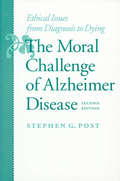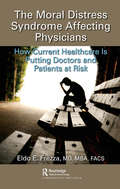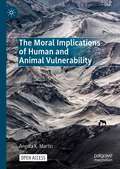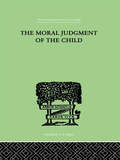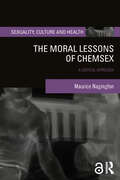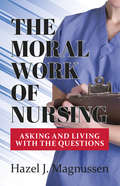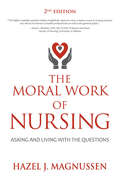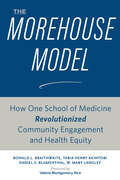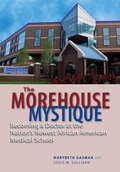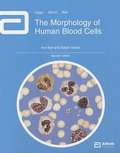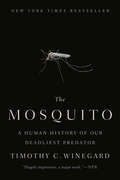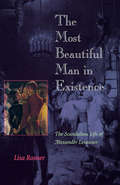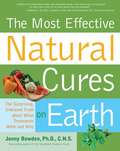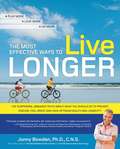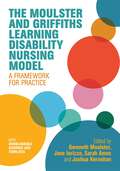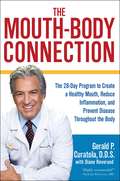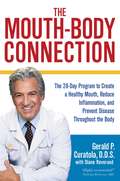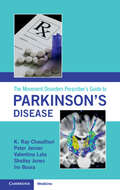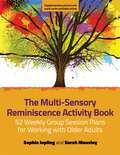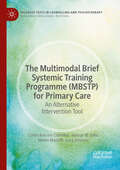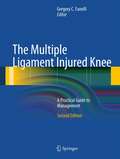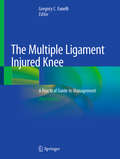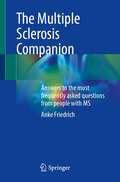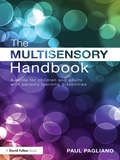- Table View
- List View
The Moral Challenge of Alzheimer Disease: Ethical Issues from Diagnosis to Dying (Gerontology)
by Stephen G. PostSociety today, writes Stephen Post, is "hypercognitive": it places inordinate emphasis on people's powers of rational thinking and memory. Thus, Alzheimer disease and other dementias, which over an extended period incrementally rob patients of exactly those functions, raise many dilemmas. How are we to view—and value—persons deprived of what some consider the most important human capacities?In the second edition of The Moral Challenge of Alzheimer Disease, Post updates his highly praised account of the major ethical issues relating to dementia care. With chapters organized to follow the progression from mild to severe and then terminal stages of dementia, Post discusses topics including the experience of dementia, family caregiving, genetic testing for Alzheimer disease, quality of life, and assisted suicide and euthanasia. New to this edition are sections dealing with end-of-life issues (especially artificial nutrition and hydration), the emerging cognitive-enhancing drugs, distributive justice, spirituality, and hospice, as well as a critique of rationalistic definitions of personhood. The last chapter is a new summary of practical solutions useful to family members and professionals.
The Moral Distress Syndrome Affecting Physicians: How Current Healthcare is Putting Doctors and Patients at Risk
by Eldo E. Frezza, MD, MBA, FACSThe rise of suicide and burnout among physicians has brought a new disease to the healthcare provider, which we previously thought only affected the soldier: moral distress syndrome, second only to moral injury. In this book we introduce the concept of moral distress syndrome, which includes any or all of the following: depression, PTSD, risk of suicide, divorce, emotional detachment, and the inability to build healthy relationships and empathy. While veterans can report to veteran hospitals for treatment, the physician cannot find treatment or support without fear of losing their license, their hospital privileges, and their job. Therefore, they are stuck dealing with the issue themselves, along with their family or their circle of friends. To raise decisive awareness of the problems related to moral distress, we wrote this book. This book is designed around physicians talking to other physicians about their moral distresses in a safe space. It brings all the aspects of the moral distress syndrome in a format familiar to the physician: grand rounds with a magistral lecture, where the audience asks the question and directly participates on the subject. The reader will feel like part of the audience and may want to ask their own questions as the book progresses. The format of the book is divided into three parts. In the first part, the research, data, and a crude number of problems are given: moral distress syndrome, PTSD, burnout, suicide, divorce rates, emotional detachment, legal distress syndrome, physicians leaving medicine, and the feeling of being a hamster in a wheel. In the second part, we embellish on real life experiences of physicians to highlight the pain and depth of the moral distress they feel. We share stories around the character—their family, love life, divorce, etc.—to show the individual person behind the doctor. In the third part, we focus on society and physician suffering and the birth of moral distress. This part focuses on the physician’s empathy as a way to point out his problems, weaknesses, and issues, and find possible solutions for him and other physicians facing the same issues. At the end of the third part, we discuss how it is the responsibility of physicians, patients, and society as a whole to heal in the face of moral injury, as recommended by the American Medical Association. We finish with the search for good friends and safe spaces, the cornerstones for the healing process. Structure of the Chapters. To make it easier to follow the material, at the beginning of each chapter we outline the points discussed, as a speaker outlines the material, summarizing it in the first slide of each topic. We hope that this way the readers can focus on the issues quickly throughout the book. This book is formatted as a business novel and therefore the characters and situations are drawn from liberally. As well as reading like a novel, the reader can read each chapter separately and still understand the points.
The Moral Implications of Human and Animal Vulnerability
by Angela K. MartinIn this open access book, Angela K. Martin thoroughly addresses what human and animal vulnerability are, how and why they matter from a moral point of view, and how they compare to each other. By first defining universal and situational human vulnerability, Martin lays the groundwork for investigating whether sentient nonhuman animals can also qualify as vulnerable beings. She then takes a closer look at three different contexts of animal vulnerability: animals used as a source of food, animals used in research, and the fate of wild animals.
The Moral Judgment Of The Child (International Library Of Psychology Ser.)
by Piaget, JeanFirst Published in 1999. Routledge is an imprint of Taylor & Francis, an informa company.
The Moral Lessons of Chemsex: A Critical Approach (Sexuality, Culture and Health)
by Maurice NagingtonThis book explores how gay and bi men’s lived experiences of chemsex intersect with its cultural representations. It argues that while normative moral frameworks are often used to talk about chemsex, chemsex sub-cultures contain their own valuable moral frameworks that can provide lessons about some of the most pressing concerns of contemporary society.Drawing from a tradition of scholarship that views queer sub-cultures as having pedagogical value for all of society, Maurice Nagington critiques norms that govern lives in relation to: the interactions of bodies, sex and capitalism, trauma and tragedy, the regulation of boundaries, and the disciplinary apparatuses in modern society. Each chapter takes its lead from themes informed by the analysis of longitudinal interviews conducted over a two-year period by the author and an archive of materials concerning chemsex such as films, soundtracks, health promotion pamphlets, newspaper articles, blogs, and ethnographic field notes. Linking the accounts of interviewees to wider debates about and representations of chemsex, this innovative book develops a cohesive narrative about the moral lessons chemsex can teach us.Contributing to the emerging field of critical chemsex studies, this volume is of interest to advanced students and scholars interested in gender and sexuality studies, sociology of health and illness, medical anthropology, critical public health and criminology, as well those who are involved in chemsex and wish to read and reflect about it as more than just a problem. The Open Access version of this book, available at http://www.taylorfrancis.com, has been made available under a Creative Commons [Attribution-Non Commercial-No Derivatives (CC-BY-NC-ND)] 4.0 license.
The Moral Work of Nursing
by Hazel MagnussenReviewing and integrating lived experiences in nursing with theory and research, The Moral Work of Nursing is a blend of life story and overview of factors affecting ethical nursing practice during the past 50 years. Reflecting on her 35-year nursing career, studies in health care ethics in the 1980s and recent developments in Canadian health care, Magnussen invites readers to ponder moral questions about the work of nurses in community, hospital and long term care settings. Nurses' moral work requires reflection on practice, sensitivity to moral issues, courage to ask questions and take action when patientcare is compromised. When concerns are not taken seriously, and systemic or other constraints make it difficult or impossible to act morally, nurses experience moral distress. They are torn between their professional commitment to safe, competent, compassionate and ethical care for patients/clients, and their personal responsibility to remain healthy and fit to practice in ever-changing health care environments.
The Moral Work of Nursing: Asking and living with the questions
by Hazel J. MagnussenReviewing and integrating lived experiences in nursing with theory and research, The Moral Work of Nursing is a blend of life story and overview of factors affecting ethical nursing practice during the past 50 years. Reflecting on her 35-year nursing career, studies in health care ethics in the 1980s and recent developments in Canadian health care, Magnussen invites readers to ponder moral questions about the work of nurses in community, hospital and long term care settings. Nurses’ moral work requires reflection on practice, sensitivity to moral issues, courage to ask questions and take action when patient care is compromised. When concerns are not taken seriously, and systemic or other constraints make it difficult or impossible to act morally, nurses experience moral distress. They are torn between their professional commitment to safe, competent, compassionate and ethical care for patients/clients, and their personal responsibility to remain healthy and fit to practice in ever-changing health care environments.
The Morehouse Model: How One School of Medicine Revolutionized Community Engagement and Health Equity
by Ronald L. Braithwaite Tabia Henry Akintobi Daniel S. Blumenthal W. Mary LangleyHow can the example of Morehouse School of Medicine help other health-oriented universities create ideal collaborations between faculty and community-based organizations?Among the 154 medical schools in the United States, Morehouse School of Medicine stands out for its formidable success in improving its surrounding communities. Over its history, Morehouse has become known as an institution committed to community engagement with an interest in closing the health equity gap between people of color and the white majority population. In The Morehouse Model, Ronald L. Braithwaite and his coauthors reveal the lessons learned over the decades since the school's founding—lessons that other medical schools and health systems will be eager to learn in the hope of replicating Morehouse's success. Describing the philosophical, cultural, and contextual grounding of the Morehouse Model, they give concrete examples of it in action before explaining how to foster the collaboration between community-based organizations and university faculty that is essential to making this model of care and research work. Arguing that establishing ongoing collaborative projects requires genuineness, transparency, and trust from everyone involved, the authors offer a theory of citizen participation as a critical element for facilitating behavioral change. Drawing on case studies, exploratory research, surveys, interventions, and secondary analysis, they extrapolate lessons to advance the field of community-based participatory research alongside community health.Written by well-respected leaders in the effort to reduce health inequities, The Morehouse Model is rooted in social action and social justice constructs. It will be a touchstone for anyone conducting community-based participatory research, as well as any institution that wants to have a positive effect on its local community.
The Morehouse Mystique: Becoming a Doctor at the Nation's Newest African American Medical School
by Marybeth GasmanThe Morehouse School of Medicine in Atlanta, Georgia, is one of only four predominantly Black medical schools in the United States. Among its illustrious alumni are surgeons general of the United States, medical school presidents, and numerous other highly regarded medical professionals. This book tells the engrossing history of this venerable institution.The school was founded just after the civil rights era, when major barriers prevented minorities from receiving adequate health care and Black students were underrepresented in predominantly White medical schools. The Morehouse School of Medicine was conceived to address both problems—it was a minority-serving institution educating doctors who would practice in underserved communities.The school's history involves political maneuvering, skilled leadership, dedication to training African American physicians, and a mission of primary care in disadvantaged communities. Highlighting such influential leaders as former Health and Human Services Secretary Louis W. Sullivan, The Morehouse Mystique situates the school in the context of the history of medical education for Blacks and race relations throughout the country. The book features excerpts from personal interviews with prominent African American doctors as well as with former presidents Jimmy Carter and George H. W. Bush, who reveal how local, state, and national politics shaped the development of Black medical schools in the United States.The story of the Morehouse School of Medicine reflects the turbulent time in which it was founded and the lofty goals and accomplishments of a diverse group of African American leaders. Their tireless efforts in creating this eminent Black institution changed the landscape of medical education and the racial and ethnic makeup of physicians and health care professions.
The Morphology of Human Blood Cells (Seventh Edition)
by Ann Bell Sabah SallahThe book portrays the morphologic characteristics of normal and pathologic cells in blood and bone marrow. It will benefit medical students, student medical technologists, and other health science students who are learning to identify the various types of blood cells.
The Mosquito: A Human History of Our Deadliest Predator
by Timothy C. Winegard**The instant New York Times bestseller.***An international bestseller.*Finalist for the Lane Anderson AwardFinalist for the RBC Taylor Award&“Hugely impressive, a major work.&”—NPRA pioneering and groundbreaking work of narrative nonfiction that offers a dramatic new perspective on the history of humankind, showing how through millennia, the mosquito has been the single most powerful force in determining humanity&’s fate Why was gin and tonic the cocktail of choice for British colonists in India and Africa? What does Starbucks have to thank for its global domination? What has protected the lives of popes for millennia? Why did Scotland surrender its sovereignty to England? What was George Washington's secret weapon during the American Revolution? The answer to all these questions, and many more, is the mosquito. Across our planet since the dawn of humankind, this nefarious pest, roughly the size and weight of a grape seed, has been at the frontlines of history as the grim reaper, the harvester of human populations, and the ultimate agent of historical change. As the mosquito transformed the landscapes of civilization, humans were unwittingly required to respond to its piercing impact and universal projection of power. The mosquito has determined the fates of empires and nations, razed and crippled economies, and decided the outcome of pivotal wars, killing nearly half of humanity along the way. She (only females bite) has dispatched an estimated 52 billion people from a total of 108 billion throughout our relatively brief existence. As the greatest purveyor of extermination we have ever known, she has played a greater role in shaping our human story than any other living thing with which we share our global village. Imagine for a moment a world without deadly mosquitoes, or any mosquitoes, for that matter? Our history and the world we know, or think we know, would be completely unrecognizable. Driven by surprising insights and fast-paced storytelling, The Mosquito is the extraordinary untold story of the mosquito&’s reign through human history and her indelible impact on our modern world order.
The Most Beautiful Man in Existence
by Lisa Rosner1833, Catherine Jane Hamilton returned from India to Edinburgh to seek a divorce from her husband, the physician Alexander Lesassier. The charge was adultery, and proof for it lay in a trunk containing her husband's personal papers. Catherine won her suit without difficulty and the trunk was deposited in the library of the Royal College of Physicians of Edinburgh. Alexander Lesassier died in 1839 during the First Afghan War; his trunk and its contents remained untouched for the next century and a half.It has now been opened and a remarkable tale, told in remarkable detail, has spilled forth. The life of Alexander Lesassier, as expertly reconstructed by Lisa Rosner, affords startling insight into the sensibilities of an era and of the man who, in his own eyes and those of the women who adored him, was its most perfect creation.Affable and self-absorbed, engaging and ignoble Lesassier was a physician, military surgeon, and novelist, who was also a shameless opportunist, charming scoundrel, seducer, and survivor. His is the story of a failed medical man who wanted to be something different and saw himself as entitled to more than he had; someone who can always be guaranteed to make the wrong choice, and then protest that he has done well.This fascinating and deeply absorbing book offers rare insights into Georgian, Regency, and early Victorian Britain through the fortunes and misfortunes, hopes and whims, of "the most beautiful man in existence."
The Most Effective Natural Cures on Earth: What Treatments Work and Why
by Jonny BowdenTake back your health naturally-without the drugs, side effects, and hassle! Acclaimed nutritionist and best-selling author Jonny Bowden, Ph.D., C.N.S., identifies and explains the best in alternative medicine today using extensive research, wide-ranging expertise in nutrition and health, and advice from myriad health experts. Jonny empowers you to take charge of your health by showing which alternative treatments work, how to use them effectively, and in what dosages. He tells you which foods, vitamins, minerals, herbs, amino acids, and natural treatments, such as exercise and relaxation therapies, will treat your conditions. Backed by scientific studies. Jonny shows you how to use: CINNAMON to moderate blood sugar MELATONIN to relieve jet lag VITAMIN C to protect against cancer CELERY to lower blood pressure BLACK COHOSH to ease hot flashes ACUPUNCTURE to treat infertility specific diet modifications to help with ALLERGIES, ACNE, and ULCERATIVE COLITIS This book details the most effective combinations of different "cures," plus Jonny picks the top six treatments that he'd take with him if stranded on a desert island. His treatments address more than seventy-five specific health concerns, including cancer, high cholesterol, eczema, hypertension. PMS. stress, menopause, diabetes, autism, depression, and high blood pressure.
The Most Effective Ways to Live Longer: The Surprising, Unbiased Truth about What You Should Do to Prevent Disease, Feel Great, and Have Optimum Health and Longevity
by Jonny BowdenAuthor Jonny Bowden looks at what he calls "The Four Horsemen of Aging"--free radicals, inflammation, glycation, and stress--and shows how they can harm your health and shorten your life. Bowden then unveils an arsenal of anti-aging strategies culled from cutting edge research and lessons learned from the longest lived people on the planet. He examines how the major organs, such as the heart and the brain, age and how you can prevent damage to these vital parts of the body. In total, readers learn what they can eat, do, and take to feel great, avoid illness, and live a long life.
The Moulster and Griffiths Learning Disability Nursing Model: A Framework for Practice
by Elizabeth Bailey Tom Griffiths Helen Laverty Emily Smith Dave Atkinson Daniel Turner Gweneth Moulster Jane Iorizzo Sarah Ames Joshua Kernohan Hayley Goleniowska Marina Russ Lauretta Edmondson Chris Edmondson Sally Edmondson Ball Trish Griffin Lynne Westwood Elaine Thomas Norah Arnott Fiona Gibney Johnann WilsonThis book describes the Moulster and Griffiths nursing model and demonstrates how learning disability nurses can use it in practice. It provides an effective framework to assess, plan, reflect on and evaluate person-centred care, considering the complex needs of people who have learning disabilities, their families and their carers.
The Mouth-Body Connection: The 28-Day Program to Create a Healthy Mouth, Reduce Inflammation and Prevent Disease Throughout the Body
by Diane Reverand Gerald P. CuratolaAcclaimed oral health expert and wellness pioneer, Dr. Gerry Curatola, explores the bi-directional relationship between the health of your mouth and your body, and provides a groundbreaking program for creating a healthy mouth that will help maintain a healthy body. The mouth acts as mirror and a gateway and reflects what is happening in the rest of your body and the health of your mouth appears to have a profound impact on the rest of your body. Chronic, low-grade oral disease is a major source of inflammation throughout your body, which can sometimes result in serious systemic problems, including cardiovascular disease, type 2 diabetes, obesity, and premature birth. The Mouth-Body Connection educates the reader on the natural ecology of the mouth. The oral microbiome consists of communities of 20 billion microorganisms of more than six hundred types-keeping these communities balanced is the key to well-being. Dr. Curatola's program, thirty years in the making, helps to restore microbiome balance and reduce health-destroying inflammation. The Curatola Care Program fosters a healthy oral microbiome by means of diet, supplements, exercise, and stress reduction. Four weeks of meal plans and fifty delicious recipes will convince you that eating for balance can be a treat. There are supplement schedules for each stage, two high-intensity band workouts that take only 15 minutes twice a week, relaxation techniques, and yoga postures to fight inflammation.In just four weeks, you will reboot your body and begin to take control of your health. Best of all, your brilliant smile will prove that you have never felt better. p.p1 {margin: 0.0px 0.0px 0.0px 0.0px; font: 12.0px Geneva} p.p2 {margin: 0.0px 0.0px 0.0px 0.0px; text-indent: 36.0px; font: 12.0px Geneva} p.p3 {margin: 0.0px 0.0px 0.0px 0.0px; text-indent: 36.0px; font: 12.0px Geneva; min-height: 16.0px} p.p4 {margin: 0.0px 0.0px 0.0px 0.0px; font: 12.0px Geneva; min-height: 16.0px} span.s1 {font: 12.0px Symbol}
The Mouth-Body Connection: The 28-Day Program to Create a Healthy Mouth, Reduce Inflammation and Prevent Disease Throughout the Body
by Diane Reverand Gerald P. CuratolaAcclaimed oral health expert and wellness pioneer, Dr. Gerry Curatola, explores the bi-directional relationship between the health of your mouth and your body, and provides a groundbreaking program for creating a healthy mouth that will help maintain a healthy body. The mouth acts as mirror and a gateway and reflects what is happening in the rest of your body and the health of your mouth appears to have a profound impact on the rest of your body. Chronic, low-grade oral disease is a major source of inflammation throughout your body, which can sometimes result in serious systemic problems, including cardiovascular disease, type 2 diabetes, obesity, and premature birth. The Mouth-Body Connection educates the reader on the natural ecology of the mouth. The oral microbiome consists of communities of 20 billion microorganisms of more than six hundred types-keeping these communities balanced is the key to well-being. Dr. Curatola's program, thirty years in the making, helps to restore microbiome balance and reduce health-destroying inflammation. The Curatola Care Program fosters a healthy oral microbiome by means of diet, supplements, exercise, and stress reduction. Four weeks of meal plans and fifty delicious recipes will convince you that eating for balance can be a treat. There are supplement schedules for each stage, two high-intensity band workouts that take only 15 minutes twice a week, relaxation techniques, and yoga postures to fight inflammation.In just four weeks, you will reboot your body and begin to take control of your health. Best of all, your brilliant smile will prove that you have never felt better. p.p1 {margin: 0.0px 0.0px 0.0px 0.0px; font: 12.0px Geneva} p.p2 {margin: 0.0px 0.0px 0.0px 0.0px; text-indent: 36.0px; font: 12.0px Geneva} p.p3 {margin: 0.0px 0.0px 0.0px 0.0px; text-indent: 36.0px; font: 12.0px Geneva; min-height: 16.0px} p.p4 {margin: 0.0px 0.0px 0.0px 0.0px; font: 12.0px Geneva; min-height: 16.0px} span.s1 {font: 12.0px Symbol}
The Movement Disorders Prescriber's Guide to Parkinson's Disease
by K. Ray Chaudhuri Peter Jenner Valentina Leta Shelley Jones Iro BouraThis concise, yet authoritative, clinical reference guide fulfils the needs of diverse clinicians, pharmacists and allied health professionals prescribing for Parkinson's disease and movement disorders in contemporary clinical practice. With chapters on newly approved drugs and their effects on motor and non-motor symptoms, information is also given on their use in particular populations including the elderly and patients with cognitive impairment. Each chapter includes pharmacological/biochemical rationale for drug use, a general guide to therapeutic use, pharmacokinetics, interaction profile, adverse effects, dosing and use, special population considerations, costs and value for money considerations, clinical vignette, a summary overview, and suggested reading. Ordered alphabetically and perfect for quick reference use, the guide is practical and essential for all prescribers with responsibility for patients with Parkinson's disease, including neurologists, geriatricians, internists, neurosurgeons, psychiatrists, family physicians, pharmacists as well as allied health professionals and resident, fellow, and student trainees in all related medical fields.
The Multi-Sensory Reminiscence Activity Book: 52 Weekly Group Session Plans for Working with Older Adults
by Sophie Jopling Sarah MousleyWith a key theme for every week of the year, this resource contains extended multi-sensory reminiscence group session plans for older adults. Written by experienced occupational therapists, it provides detailed session plans for running successful and therapeutically-valuable activities within group sessions, from remembering school days to celebrating the natural wonders of the British Isles. Each plan has been developed to be suitable for people with a variety of abilities, including for those with dementia, and help to support memory, sensory function, confidence, communication, connection, as well as overall physical and emotional wellbeing. Activities range from cognitive activities such as word games, food tasting, music and poetry to group discussions. Session plans are accompanied by downloadable colour photographs and word cards to be used as tools for discussion.
The Multimodal Brief Systemic Training Programme: An Alternative Intervention Tool (Palgrave Texts in Counselling and Psychotherapy)
by Mauro Mariotti Carles Barcons Comellas George W. Saba Cory JohnsonThis textbook presents an innovative educational and training protocol for treating mental health patients in primary care: the Multimodal Brief Systemic Training (MBSTP). Blending theory with practice, this manual offers a rigorous, versatile, and integrative approach, grounded in research, that can be easily adopted by primary care professionals—including general practitioners, nurses, social workers, and psychologists. It is not only invaluable for psychotherapy students but also serves as a vital resource for physicians and other non-mental health professionals seeking to support individuals facing cancer, chronic pain, palliative care, and other conditions that intertwine emotional, mental, and behavioural challenges within their close relational systems. The MBSTP is a compelling alternative to existing evidence-based training programs, which often centre on Cognitive Behavioural Therapy. Designed as a continuing education course led by a team of mental health specialists, this training provides a structured pathway for professional development. This book will help to reignite practitioners' interest in systemic thinking, encouraging them to revisit its significance in their work, or, for those new to the concept, to embrace it as a crucial aspect of their professional growth and contribute meaningfully to their evolution in the field.
The Multiple Ligament Injured Knee
by Gregory C. FanelliThe Multiple Ligament Injured Knee: A Practical Guide to Management includes the most developed knowledge needed to successfully diagnose and treat knee ligament injuries. This thorough work presents anterior and posterior cruciate and collateral ligament anatomy and biomechanics along with non-invasive methods for diagnosing the extent of injury, such as radiographic and arthroscopic evaluation. Various injuries are discussed in addition to useful treatment techniques, including arthroscopic reconstruction, posterolateral and posteromedial corner injury and treatment, assessment and treatment of vascular injuries, assessment and treatment of nerve injuries, rehabilitation, and post-operative results. Each of these clearly written chapters is accompanied by a wealth of line drawings and photographs that demonstrate both the surgical and non-surgical approaches to examination and treatment.
The Multiple Ligament Injured Knee: A Practical Guide to Management
by Gregory C. FanelliThe Multiple Ligament Injured Knee: A Practical Guide to Management includes the most developed knowledge needed to successfully diagnose and treat knee ligament injuries. This thorough work presents anterior and posterior cruciate and collateral ligament anatomy and biomechanics along with non-invasive methods for diagnosing the extent of injury, such as radiographic and arthroscopic evaluation. Various injuries are discussed in addition to useful treatment techniques, including arthroscopic reconstruction, posterolateral and posteromedial corner injury and treatment, assessment and treatment of vascular injuries, assessment and treatment of nerve injuries, rehabilitation, and post-operative results. Each of these clearly written chapters is accompanied by a wealth of line drawings and photographs that demonstrate both the surgical and non-surgical approaches to examination and treatment.
The Multiple Sclerosis Companion: Answers to the most frequently asked questions from people with MS
by Anke FriedrichThe book provides competent assistance to all those affected by Multiple Sclerosis to better understand the disease and educates them about current diagnostic methods and treatment approaches. With independent information, the guidebook provides the key to a self-determined life with the disease. Complex medical facts such as the malfunctioning immune system or MRI findings are explained in understandable words and accompanying drawings. This companion also raises awareness beyond conventional medicine to take into account important influencing environmental factors.The author provides answers to the many questions that are asked again and again in the doctors’ practices and cannot always be answered to this extent and with this clarity due to time restrictions. For this reason, it is a highly helpful tool to both MS practitioner and patient.The book is structured as follows:What is MS? - How the central nervous system is structured - What happens when the nervous system is misdirected - MS relapse and typical symptoms - The path to diagnosis - An excursion into our immune system - The MRI findings - Why lumbar puncture - What to do during an MS relapse - I'm fine, why therapy? - MS and the desire to have children - What can I do myself: Nutrition, Vitamin D, intestine and microbiome.
The Multisensory Handbook: A guide for children and adults with sensory learning disabilities
by Paul PaglianoDo you support a child or adult with sensory perceptual issues or cognitive impairment? For people with challenging sensory and cognitive conditions, everyday life can become so unpredictable and chaotic that over time, lack of engagement can often lead to a state of learned helplessness. In this insightful text, Paul Pagliano shows how ‘learned helplessness’ can be transformed into learned optimism through multisensory stimulation, and explains how a programme of support can be designed and modulated to match the person’s needs, interests and abilities. Full of practical, easy to use multisensory assessment tools and intervention strategies, this book will help: foster a feeling of ease with the environment the child or adult experience pleasure and happiness kick-start their desire to explore encourage improved learning, social well-being and quality of life. The author offers an abundance of exciting multisensory stimulation ideas that can be applied to communication, play, leisure and recreation, therapy and education. Practical resources also show how to monitor and review applications to ensure they are being used in the most effective and enjoyable ways possible. Informed by an astute, up-to-date, comprehensive overview of research and theory, The Multisensory Handbook will appeal to primary professionals from a wide range of disciplines including education, health and social care.
The Musculoskeletal System
by Philip James Adds Somayyeh ShahsavariThe Musculoskeletal System is an anatomy reference and revision guide combining detailed illustrations with a strong clinical focus to allow an easier correlation between anatomy and practice. This highly illustrated guide, separated in manageable sections by anatomical area, provides a compact and complete account of the body's complex system of b
